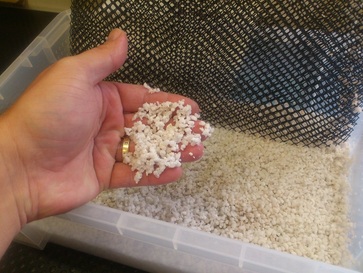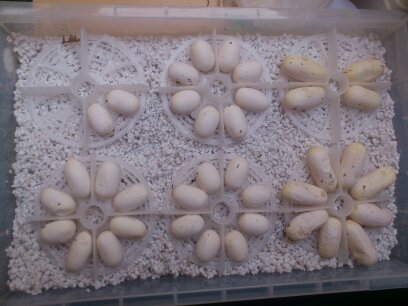My Incubation methods
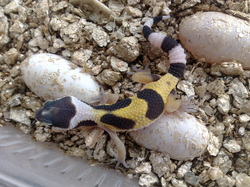
Many People have asked me how I incubate my reptile eggs, so here’s an explanation with some Photos of the few methods I use.
These methods have worked perfectly for me in the past years, but that doesn’t mean they are hard and fast rules as to how to do it. There are many methods used by breeders, these are just my preferred methods.
One thing to remember with all of my methods is that I sterilise the incubation boxes before each use, I use F10SC for this. Then I always clean my hands with sterilising hand gel before and after handling the eggs.
Another thing to decide is depending on what Species eggs I’m incubating, depends on the size and type of incubation box that I will use.
I will use a Chicken egg, as a size guide for depths of substrate and illustration purposes. Also please remember that reptile eggs, as a rule, do not have a hard shell, like a bird’s egg. Generally most species eggs are soft and leathery. Reptile eggs do not need turning unlike a bird’s egg. In fact if you do turn a reptile egg, you can cause more harm than good, possibly destroying the embryo inside.
These methods have worked perfectly for me in the past years, but that doesn’t mean they are hard and fast rules as to how to do it. There are many methods used by breeders, these are just my preferred methods.
One thing to remember with all of my methods is that I sterilise the incubation boxes before each use, I use F10SC for this. Then I always clean my hands with sterilising hand gel before and after handling the eggs.
Another thing to decide is depending on what Species eggs I’m incubating, depends on the size and type of incubation box that I will use.
I will use a Chicken egg, as a size guide for depths of substrate and illustration purposes. Also please remember that reptile eggs, as a rule, do not have a hard shell, like a bird’s egg. Generally most species eggs are soft and leathery. Reptile eggs do not need turning unlike a bird’s egg. In fact if you do turn a reptile egg, you can cause more harm than good, possibly destroying the embryo inside.
Classic Sphagnum Moss.
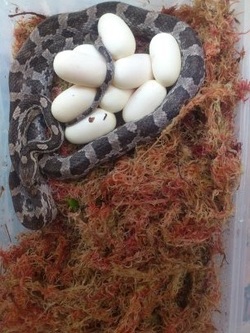
this is an egg laying box but you can get the jist from it.
I have chosen the size box I need, cleaned it with F10SC and washed my hands.
Sphagnum Moss comes in either fresh packed or dried in blocks. If you buy the dried stuff in blocks you need to soak it in warm water, until it has fully absorbed the water you added. Once you have soft damp Moss, place a layer of around 2”-4” of it in to the bottom of the Incubation box. Then place the Eggs on top of this substrate, then once all the eggs are in place, loosely wrap more Moss around the eggs but not completely covering them. Place the lid back on the box and put it into the incubator.
It is important to add, that this should be done prior to egg laying, and be ready heated in the incubator.
Sphagnum Moss comes in either fresh packed or dried in blocks. If you buy the dried stuff in blocks you need to soak it in warm water, until it has fully absorbed the water you added. Once you have soft damp Moss, place a layer of around 2”-4” of it in to the bottom of the Incubation box. Then place the Eggs on top of this substrate, then once all the eggs are in place, loosely wrap more Moss around the eggs but not completely covering them. Place the lid back on the box and put it into the incubator.
It is important to add, that this should be done prior to egg laying, and be ready heated in the incubator.
Vermiculite And Pearlite.

Vermiculite can be purchased at low cost from any Garden centre. It is a natural Mineral that is mined. It has many uses from aerating soil to insolation. To say it is versatile is an understatement.
I, and many other breeders, have used it as an incubating substrate for many years. It is a little messy to prepare but is tried and tested as a very good medium to use.
All I do is add warm water to the dry vermiculite in a clean bucket. I add enough so the vermiculite bonds together, only being able to squeeze a very little water from it.
Depending on the size egg you need to incubate (let’s use a chicken egg as a size guide) you need enough Vermiculite to comfortably cushion the eggs. If we use a Chicken egg as an example, I would use a minimum depth of 3” of substrate below the lowest part of the egg (egg on its side) so you would need around (Chicken eggs are around 1 ½” diameter across the middle) 4” of vermiculite as you need to slightly bury the egg, leaving a little of it exposed.
Once this is done I would put the lid on and place it back into the incubator.
I use the same method for Pearlite.
I, and many other breeders, have used it as an incubating substrate for many years. It is a little messy to prepare but is tried and tested as a very good medium to use.
All I do is add warm water to the dry vermiculite in a clean bucket. I add enough so the vermiculite bonds together, only being able to squeeze a very little water from it.
Depending on the size egg you need to incubate (let’s use a chicken egg as a size guide) you need enough Vermiculite to comfortably cushion the eggs. If we use a Chicken egg as an example, I would use a minimum depth of 3” of substrate below the lowest part of the egg (egg on its side) so you would need around (Chicken eggs are around 1 ½” diameter across the middle) 4” of vermiculite as you need to slightly bury the egg, leaving a little of it exposed.
Once this is done I would put the lid on and place it back into the incubator.
I use the same method for Pearlite.
Suspended egg Incubation.

Firstly I have filled the box with whatever incubation medium/substrate I wish to use. Then I stretch women’s tights/suspenders over the edge of the incubation box. Then place the eggs on this so the eggs are suspended over your choice of incubation substrate.
The advantages of this method is that the eggs still get the required humidity needed, but without the mess, also if your incubation substrate gets a little too dry, you can add warm water to it without the risk of spoiling the eggs.
But on the down side, the egg’s all fall/roll to the middle of the box.
The advantages of this method is that the eggs still get the required humidity needed, but without the mess, also if your incubation substrate gets a little too dry, you can add warm water to it without the risk of spoiling the eggs.
But on the down side, the egg’s all fall/roll to the middle of the box.
Substrate-less Incubation.
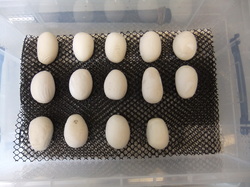
The plastic gauze is from the Pound shop.
The title is not entirely true, I do use a substrate, however the eggs are not directly placed in it, very similar to the suspended method.
I prefer to use Pearlite for this method, this will become apparent as I explain I will add some photos as soon as I have time to set up some incubation boxes.
Pearlite is a very good moisture retainer. It is a white, very light, Soft, gravel like substrate. I would use the same rule for depth as the Vermiculite method, using around 2”-3” depth. Then I place a piece of plastic egg crate, perforated plastic or plastic mesh on top.
The eggs are placed on top of the Mesh, so they are not in direct contact with the Pearlite. Because of the Pearlite’s properties, you can actually see the water level through the side of your incubation box.
This is ideal as you can actually add more water than needed, if the pearlite dried out too much, without any of the water touching the eggs that would normally spoil them.
I prefer to use Pearlite for this method, this will become apparent as I explain I will add some photos as soon as I have time to set up some incubation boxes.
Pearlite is a very good moisture retainer. It is a white, very light, Soft, gravel like substrate. I would use the same rule for depth as the Vermiculite method, using around 2”-3” depth. Then I place a piece of plastic egg crate, perforated plastic or plastic mesh on top.
The eggs are placed on top of the Mesh, so they are not in direct contact with the Pearlite. Because of the Pearlite’s properties, you can actually see the water level through the side of your incubation box.
This is ideal as you can actually add more water than needed, if the pearlite dried out too much, without any of the water touching the eggs that would normally spoil them.
